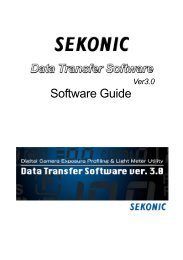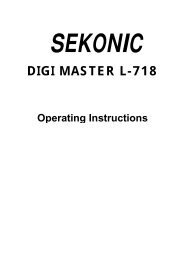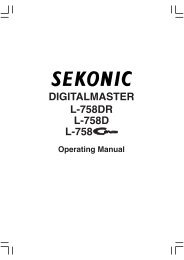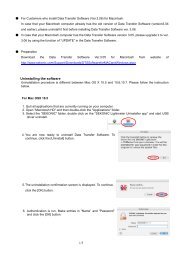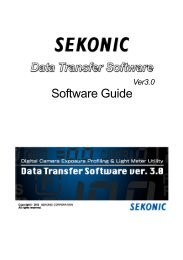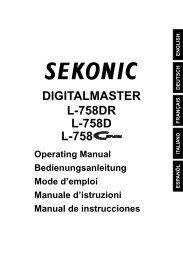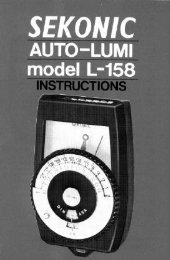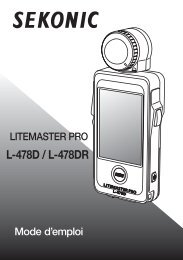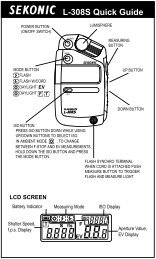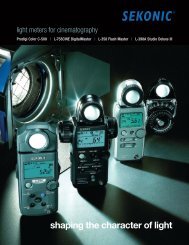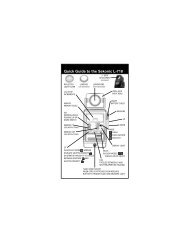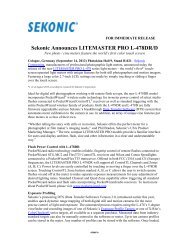Sekonic L-608 Manual
Sekonic L-608 Manual
Sekonic L-608 Manual
Create successful ePaper yourself
Turn your PDF publications into a flip-book with our unique Google optimized e-Paper software.
Super Zoom MasterL-<strong>608</strong>/L-<strong>608</strong>Operating <strong>Manual</strong>
Blank page
Congratulations on your purchase of a<strong>Sekonic</strong> Super Zoom Master L-<strong>608</strong>/L-<strong>608</strong>CINEExposure Meter.The Super Zoom Master L-<strong>608</strong>/L-<strong>608</strong>CINE is the latest addition to the extensiveline of <strong>Sekonic</strong> Exposure Meters which have been market leaders.It was designed to be the ultimate meter, a do-all instrument for the most demandingpros.It is the first zoom spot meter with digital spot viewfinder readout on the market.Nine camera-quality lens elements are required to accomplish its 1° to 4° zoomrange.its sealed housing and controls make it water and moisture resistant.Yes, you can use it in the rain, but it is not an underwater meter.The large LCD display makes reading easy, and it lights up automatically in darksurroundings.In order not to crowd the controls, four functions which are less frequently used,are confined to DIP switches, located in the battery compartment.Because of its many features, the L-<strong>608</strong>/L-<strong>608</strong>CINE requires this rather extensivemanual. But since you will never use all of the function at the same time, once youhave learned all about it, it is simple and its use will become second nature.The Super Zoom Master L-<strong>608</strong>/L-<strong>608</strong>CINE has undergone extensive qualitycontrols at every step of manufacture. Please read this instruction manualthoroughly, to be able to take advantage of its many features and to obtain thelong service life it is designed for.Thank you for your confidence in <strong>Sekonic</strong>.
Table of Contents1. Parts Designation ................................................................................................................ 12. Explanation of the Liquid Crystal Display (LCD) .................................................................. 2-33. Before Using ........................................................................................................................ 4-61. Attach the strap ......................................................................................................... 42. Inserting the battery .................................................................................................. 43. Checking battery capacity ......................................................................................... 44. Replacing battery during measurementor when using the memory function .......................................................................... 55. Auto Power Off function ............................................................................................. 56. Setting main ISO film speed ...................................................................................... 57. Setting second ISO film speed (ISO 2) ..................................................................... 58. Mesurement Lock and Measurement Lock Off .......................................................... 64. Basic Operation ................................................................................................................... 7-121. Incident or reflected spot measuring ......................................................................... 72. Setting measuring mode ........................................................................................... 83. Setting DIP switches .................................................................................................. 94. When set for incident light ......................................................................................... 105. When set for reflected light (spot metering) .............................................................. 115. Measurment ........................................................................................................................ 13-221. Measuring Ambient Light ........................................................................................... 131-1 Shutter Speed Priority mode ........................................................................... 131-2 Aperture Priority mode .................................................................................... 141-3 EV mode ......................................................................................................... 151-4 Cinematography .............................................................................................. 162. Measuring Flash Light ............................................................................................... 182-1 Cord Flash mode ............................................................................................. 182-2 Auto Reset Cordless Flash mode ................................................................... 192-3 Cord Multiple Flash (cumulative) mode ........................................................... 212-4 Cordless Maltiple Flash (cumulative) mode .................................................... 226. Advanced Functions ............................................................................................................ 24-351. Memory function ........................................................................................................ 242. Averaging function ..................................................................................................... 253. Brightness Difference function ................................................................................... 254. How to use an incident Illuminance (LUX or FC) Meter ............................................ 275. How to use a reflected luminance (cd/m 2 or FL) meter ............................................. 286. How to use Exposure compensation function ........................................................... 297. How to use Calibration compensation function ......................................................... 308. Filter compensation ................................................................................................... 319. Flash analyzing function ............................................................................................ 3210. Custom setting function ............................................................................................. 3311. Wireless flash radio triggering system ....................................................................... 357. Accessories ........................................................................................................................ 38-398. Technical Data ..................................................................................................................... 40-419. Safety Guide ........................................................................................................................ 4210. Care and Maintenance ........................................................................................................ 43
1. Parts Designationq Lumisphere retracting ring!4 Lock leverw Lumisphere@6 Zoom Lens Ringe Liquid Crystal Display (LCD)@7 Zoom Lens Protective Glassu Memory buttonSEKONIC@4 Eyepiece (with Diopter Adjustment)r Average / ∆ EV (Brightness Difference)buttont Jog Wheel!2 Power button(ON/OFF switch)!3 Mini Light ReceptorOutlet!1 ISO 1 buttonMEMORYPOWERISO1MODEAVE/∆EVISO2M.CLEARy ISO 2 button@5 Memory Clear buttoni Flash Synchro terminal!0 Mode set buttonSuper Zoom MasterL-<strong>608</strong>o Strap eyelet@8 Incident/Reflected SpotSelector Switch@0 Synchro Terminal Cap!5 Measuring button!6 Battery Compartment Cover@1 Strap!7 Battery Cover Latch!8 DIP Switches@3 Zoom Lens Cap@2 Connector cover@9 1/4” Tripod SocketRT-32 Radio transmittermodule compartment!9 Battery Compartment-1-
2. Explanation of the Liquid Crystal DisplayL-<strong>608</strong>!0 q w eoir!1tL-<strong>608</strong>CINEui!0 q w eoir!1tAuto Electro-Luminescent Display (EL)• In low light (EV 3 or less), a green backlight will automatically illuminate the entire LCD. When usingthe Mini Light Receptor or a Booster (optional accessories) the LCD will be illuminated after measuring,regardless of the ambient light level.• The LCD will not be automatically illuminated during measuring, in Cordless Flash mode or Wirelessflash radio triggering mode.• The Electro-luminescent backlight will automatically turn off 20 seconds after last operation.-2-uNOTE:For explanation purposes, the display illustrated here shows all icons and readoutssimultaneously. Actual display will never show as above.i
q Measuring Mode IconsAmbient (see page 13)Auto-Reset Cordless Flash (see page 19)Cord Flash (see page 18)Wireless flash radio triggering mode (see page 35)w Incident / Reflected Spot Function Icons (see page 7)Appears when in Incident modeAppears when in Reflected Spot modeertyuISO DisplayDisplays ISO film settingDisplays second ISO film setting when ISO 2 button is pressedFlash Analyzing indicator0 to 100% in 10% increments (percentage of the flash in the total exposure)+/- Compensation IndicatorAppears when +/- Compensation is set2. Explanation of the Liquid Crystal DisplayDigital aperture value, Aperture Priority, EV Brightness Difference, Average function, EV displayAppears when in Aperture Priority (f/stop) mode (see page 14)Appears when using brightness difference function (See Page 25)Appears when using Averaging function (see page 25)Appears when using EV mode (see page 15)Analog ScaleDisplays marks at apertures or shutter speed indicating full or half stop values (<strong>608</strong>),or full or 1/3stop values (<strong>608</strong> CINE) for measurement, also displays memory and average valuesAppears when below display rangeBlinks when under exposed below measurement rangeAppears when above display rangeBlinks when over exposed above measurement rangei Shutter priority indicator, shutter speed display for still photography or frames per second (f/s) forcinematographyAppears when Shutter Priority (T) mode (see page 13)Appears when shutter speed is in minutesAppears when shutter speed is in full secondsAppears when cine speed is set in frames per second (see page 16)Appears when shutter angle is set to a value other than 180 degrees (<strong>608</strong> CINE)(seepage 17)o Battery Power Indicator (see page 4)!0 Memory / Multiple Flash Indicator DisplayAppears when Multi (cumulative) flash measurement mode and shows the cumulatednumber of measurements (see page 21)Appears when reading is memorized and shows the number in memory (see page 24)!1 Illumination mark/brightness markAppears when Foot-Candle is selected (<strong>608</strong>/<strong>608</strong> CINE)Appears when Lux is selected (<strong>608</strong>/<strong>608</strong> CINE)Appears when Foot-Lambert is selected (<strong>608</strong> CINE)Appears when Cd/m 2 is selected (<strong>608</strong> CINE)-3-
3. Before Using1. Attach the strapAttach the Strap @1 by passing the small end loop through theeyelet o and passing the other end of strap through it.MOODESuper Zoom MasterL-<strong>608</strong>WARNING• Please place in a location where an infant cannot reach and accidentally get the strapwrapped around his or her neck. There is danger of strangulation.2. Inserting the battery1. Requires one 3.0 v CR123A lithium battery.2. Open the Battery compartment cover latch !7, and removethe Battery compartment cover !6.3. Insert the battery, observing the polarity with the +,- marksin the battery chamber.4. Align the tabs of the Battery compartment cover with thenotches in the back of the meter, and press down to closethe Battery cover latch.NOTE:• To prevent loss of All-weather seal, be careful that dirt does not get stuck on the rubberseal and that the seal is not damaged.• Remove battery if meter is not used for an extended period. Batteries can leak anddamage the exposure meter. Dispose of used batteries properly.• If the LCD does not light, check that the battery capacity is sufficient, and check that thebattery positive and negative terminals are not reversed.• The meter has a connector for a plug-in radio transmitter module. Do not remove theconnector cover unless you are installing the radio module, failure to do so could causethe electronic circuit board to be exposed to damaging static electricity.3. Checking battery capacity• When the Power button !2 is ON, the battery power indicator on the LCD is displayed.(Displayed) Battery power level is good.(Displayed) Battery power level is low. Have a spare battery ready.(Blinking) Replace battery immediately.-4-Reference:• We recommend you always have a spare battery on hand.• If the liquid crystal display extinguishes immediately after the display appears whenpower is first applied, that is an indication that the battery is dead. Please promptlyreplace the battery.• A3 second pause between power on and off is recommended to avoid damage to themeter.
3. Before Using4. Replacing battery during measurement or when using the memory function1. Always turn the power OFF before replacing batteries. If batteries are removed with the powerON, measurements and settings in memory can no longer be recalled.2. If after replacing the battery, or during measurements, strange screens (displays that have notbeen set) appear in the LCD, or nothing happens, no matter what button is pushed, remove thebattery and wait at least ten seconds and then replace the battery. This allows the software toautomatically reset.WARNING:• Never place batteries in fire, short, disassemble, or heat them. The batteries might breakdown, and cause an accident, injury or pollute the environment.5. Auto Power Off function1. To conserve battery power, the meter will turn off about twenty minutes after last use.2. Whether the Auto Power Saving feature turns the power off or the Power button !2 is pressed,the settings and measured values remain stored in memory. When the Power button is pressedagain the last settings are displayed.Reference:• The power shuts off automatically after 1 minute when the power button is pressed and held.6. Setting main ISO film speed1. Hold down the ISO1 button !1 and turn the Jog wheelt to select ISO film speed for the film being used.2. You can also change the ISO film speed after takingmeasurements. The new value is automaticallydisplayed.ISO 17. Setting second ISO film speed (ISO 2)1. This feature is useful when using a second film withdifferent ISO film speed, using Polaroid TM proofing film,or for exposure correction (when using a filter, closeupphotography, etc.).2. Hold down the ISO 2 button y and turn the Jog wheelto select ISO film speed of the film being used.3. Once this is set, after taking a measurement, the measuredvalue for the second film speed will be displayedwhen the ISO 2 button is pressed.4. You can also change the second ISO film speed after takingmeasurements. The new value is automatically displayed.ISO 2Reference:• The following settings are possible when using custom setting function P33.1. It is possible to set the Filter compensation within a range of ±5 EV in 1/10 steps.2. Filter factor number compensation enables you to set seven types of filters frequently usedin the CINE industry. (Kodak Wratten Filters)(<strong>608</strong> CINE only)-5-
3. Before Using8. Mode and Setting Lock or Lock Off1. Hold down the Mode set button !0 and ISO1 button !1and "LOC" will appear to indicate that the Settings arelocked. The last measurement is held until the lock isreleased, even if the Jog wheel t is accidentallymoved.However, if the measurement button !5 is pressed, anew measurement is displayed with the same lockedsettings.ISO 1MODE2. To release the Measurement lock, perform the sameoperation for the Measurement lock, Hold down theMode set button and ISO1 button and "Off" will appearto indicate that the Measurement lock is released.ISO 1MODEReference:• If power to the meter is turned off or auto off is activated when in the locked position, the diallock function will continue operating when the meter is turned on again.-6-
4. Basic Operation1. Incident or reflected spot measuring1. To set for either incident or reflected light operation, turn the Incident / Reflected Spot SelectorSwitch @8 on the eye piece, to the desired position ( or mark) until it clicks.Incident operation Reflected Spot operation2. When incident operation is selected, the mark will blink for three seconds and when ReflectedSpot operation is selected the mark will blink for three seconds on the LCD.Incident operation Reflected Spot operationNOTE:• Before taking measurements, always make sure that the desired measurement mode( or ) is chosen by checking the LCD or that the Incident/Reflected Spot SelectorSwitch is clicked in proper position.-7-
4. Basic Operation2. Setting measuring mode1. Hold down the Mode set button !0 and turn the Set/changedial t to select the desired mode. The mode switchingsequence is shown in the chart below:MODEShutter Speed Priority mode(Ambient light)See page 13Wireless Multiple FlashRadio Triggering modeSee page 37with Radiotransmitter moduleDip switch 2Aperture Priority mode(Ambient light)See page 14Wireless Flash RadioTriggering modeSee page 37with Radiotransmitter moduleEV mode (Ambient light)See page 15LUX, FCFL, Cd/m 2 → CINE onlySee page 27,28Dip switch 1Wireless Flash Sub/channelSetting modeSee page 35with Radiotransmitter moduleAuto Reset Cordless FlashmodeSee page 19Cord Multiple Flash(Cumulative) modeSee page 21Dip switch 2Cordless Multiple Flash(Cumulative) modeSee page 22Dip switch 2Cord Flash modeSee page 18-8-• Modes enclosed in dotted lines can only be selected when the respective DIP switchis in ON position (see page 8).• Modes enclosed in lines can only be selected when Optional Radio Transmitter Moduleis installed.• Each mode can be selected to display or not with custom setting.(See page 33)• FC or LUX (Illuminance) can be displayed in incident light mode.• FL or Cd/m 2 (Luminance) can be displayed in reflected light mode. (<strong>608</strong> CINE only)Reference:• Ambient light is continuous light like natural light (sunlight), fluorescent lamps or tungsten lamps.• Flash light is a brief, intense burst of light made by such as electronic flash units or flash bulbs.
4. Basic Operation3. Setting DIP Switches1. Switches for setting modes that are used infrequently are housed in the Battery compartmentof the meter. Select the mode you want prior to beginning measurements.2. The DIP switches can be set by sliding the DIP switch !8 for the mode you want to select in theON position.* EV settingsWhen DIP switch 1 is turned on, EV exposure readings are possible. (ambient light)* Multi settingsWhen DIP switch 2 is turned on, multiple flash cumulative mode is possible.* Buzzer settingWhen DIP switch 3 is on, the buzzer sounds when light from a flash is received in the cordlessmode.* CS setting (custom settings)When DIP switch 4 is on, the mode changes to the custom setting mode, thereby enablingvarious settings (refer to P33).1 2 3 4-9-
4. Basic Operation4. When set for incident light1. You can select extended or retracted lumisphere measuring positions by firmly rotating thelumisphere retracting ring (UP/DOWN) until it clicks into position.Extended LumisphereRetracted Lumisphere(Lumidisc)2. When the Lumisphere is extended. (3-D Light Measurement)This is used to photograph people, buildings, and other three dimensional objects.Measurements are basically made by the method of measuring with the lumisphere aimed inthe camera direction (more precisely, in the direction of the lens axis) at the position of thesubject.3. When the Lumisphere is retracted (flat diffuser function)This is used to photograph manuscripts, paintings or other flat copy. It can also be used formeasuring illumination levels (see page 27), or brightness difference (see page 25).NOTE:• If the device is used with the Lumisphere retracting ring in a middle position, distributedlight quality will change, and suitable measurements cannot be made.• Do not push the Lumisphere down manually. Always use the Lumisphere retracting ring.• If the lumisphere becomes soiled, wipe it with a soft, dry cloth. Organic solutions (paintthinner, benzene, etc.) must not be used under any circumstances.-10-
4. Basic Operation5. When set for reflected light (spot metering)1. This method measures the brightness (luminance) of the light reflected from the subject. It isuseful for distant objects such as landscapes, when you cannot go to the position of the subject,or for metering subjects that generate light (neon signs, etc.), highly reflective surfaces ortranslucent subjects (stained glass, etc.).2. The spot metering area can be selected by turning theZoom Lens ring @6 while looking through the viewfinderfrom the camera position.ZOOM SPOT1~4° SEKONIC3. Take the measurement by aligning the circle inside theviewfinder with the subject area to be measured.Memory4. The black circle A in the finder indicates the measurementrange. The light receiving angle is 1 degree withthe telephoto setting of the zoom lens and 4 degreeswith the wide angle.A(Display in spot viewfinder)< Diopter Adjustment >Turn the eyepiece @4 and adjust the diopter so that the circle in the finder is clearly visible whenyou look into the finder.< Step-Up Ring (Lens Hood)> (optional)The step-up ring (30.5mm → 40.5mm), available as an optional accessory, makes it possible tomount step-up rings and filters. This simplifies the setting of exposure without the troublesomecorrection calculation of polarizing filters, etc.The step-up ring can also be used as a hood to protect the zoom lens from scratching, soiling,etc.< 2x Angle Converter > (optional)Mounting the 2x angle converter to the objective lens unit enables zoom measurements at alight receiving angle of 2° - 8°.-11-
4. Basic Operation< Lumigrid > (optional) (Receiving Angle 54°)1. Remove the LumisphereThe lumisphere unit is removed by holding both theupper and lower sections of Lumisphere retractingring q and turning it counterclockwise while pushingthe Lock lever downward.2. Mount the lumigridTo mount Lumigrid, align the mount/removal indicatoron the Lumigrid with the mark and then clockwisedirection to secure it in place.3. Take measurements by aiming the lumigrid precisely at the area of the subject to be measuredfrom the position or direction of the camera.4. Follow the same procedure to mount the lumisphere.CAUTION:• Be sure to avoid touching the light receiving sensor when mounting or removing the lumisphereor lumigrid. In case of touching it, clean with soft dry cloth.-12-
5. Measurement1-2 Aperture Priority mode1. Hold down the Mode set button !0 and turn the Jog wheelto select aperture priority mode .2. Turn the Jog wheel t to set the desired f stopvalue.MODE3. Press the Measuring button !5 to make ameasurement.Release the Measuring button to complete themeasurement. The measured value (shutterspeed) at the time will be displayed.While pressing the Measuring button, themeter measures continuously until it isreleased.Measured value(shutter speed)Set f stop value1/10shutterspeedMeasured shutter speedReference:• It is possible to switch between full, 1/2 or 1/3 F stop values with custom settings.• You can set aperture from 0.5 to F161. Please note that in 1/3 stop increments F0.56 isdisplayed as and F0.63 is displayed as .• The L-<strong>608</strong> displays the measured aperture value in either full or half stop increments onthe analog scale, while L-<strong>608</strong> CINE displays it in either full or 1/3 stop increments.• Readings outside the display range or beyond the measuring range are similar to theprevious instruction (see page 13).• After measurement, the shutter speed corresponding to the F stop is displayed when theF stop is changed.-14-
1-3 EV modeOpen the Battery compartment cover !6 and slide the EV DIP switch 1 (see page 9) to the ONposition.1. Hold down the Mode set button !0 and turn theJog wheel t to select value mode.5. MeasurementMODE2. Press the Measuring button !5 to make ameasurement. Release the Measuring button tocomplete the measurement. The measured value(EV value) at that time will be displayed.ShutterspeedAt the same time, the shutter speed will bedisplayed in the digital display area, and thecorresponding f stop will be displayed on the analogscale.While pressing the measuring button, the metermeasures continuously until it is released.f stopEV valueReference:• “E.u” (Exposure under) or “E.o” (Exposure over) on the T or F display area and “U”or “O” onthe analogscale appears when the combination of shutter speed and aperture are outsidethe display range. Changing the shutter speed or aperture with the Jog wheel will allow youto find a combination that is possible.If the “E.u” or “E.o” readout and “U”or “O” on the analogscale blink, this indicates that thelight level is beyond of the measurement range of the light meter. Adjust the lighting in thiscase.-15-
5. Measurement1-4 Cinematography1. Hold down the Mode set button !0 and turn the Jog wheelt to select ambient light shutter speed priority mode.MODE2. Turn the Jog wheel to select the Cine Speed for thecamera that will be used.Cine Speed are displayed after 1/8000, 1/200, 1/400 andthe unit is in frames per second (f/s).[L-<strong>608</strong>]The following Cine Speeds will display: 2, 3, 4, 6, 8, 12,16, 18, 24, 25, 30, 32, 36, 40, 48, 50, 60, 64, 72, 96,120, 128, 150, 200, 240, 256, 300 and 360 f/s.[L-<strong>608</strong>CINE]The following Cine Speeds will display: 1, 2, 3, 4, 6, 8,12, 16, 18, 24, 25, 30, 32, 36, 40, 48, 50, 60, 64, 72, 75,90, 96, 100, 120, 125, 128, 150, 200, 240, 250, 256,300, 360, 375, 500, 625, 750 and 1000 f/s.MODE3. The shutter angle that these speeds are based on, is180 degrees. For other angles make the following ISOfilm speed corrections (L-<strong>608</strong> only).Shutter angleAmount of ISO filmspeed correction160 degrees -1/3220 degrees +1/3-16-
* Example of correction value-1/3: Decrease ISO film speed by 1/3 stop, example: ISO 80 -1/3 stop = ISO 64+1/3: Increase ISO film speed by 1/3 stop, example: ISO 80 +1/3 stop = ISO 1004. Press the Measuring button !5 to make ameasurement. Release the Measuring button tocomplete the measurement. The measured value(f stop value) will be displayed.Setshutter speed5. MeasurementMeasured f stopvalueWhile pressing the measuring button, the metermeasures continuously until it is released.1/10f stopMeasured f stopon analog displayReference:• The L-<strong>608</strong> displays the measured aperture value in either full or half stop increments on theanalog scale, while L-<strong>608</strong> CINE displays it in either full or 1/3 stop increments.• Readings outside the display range or beyond the measuring range are similar to the previousinstruction (see page 13).5. Setting the shutter angle (<strong>608</strong> CINE only).It is possible to set the shutter angle by turning the Jog wheel while pressing mode setbutton !0 and ISO2 button y .Note:• Shutter angle: The angle can be set in the range of 5° - 270° (in 5° steps) as well as144° and 172°.• "Ang" is displayed continuously on the LCD display if the shutter angle is set to anyvalue other than 180°.• Press the mode set button and ISO2 button to confirm the shutter angle since it is notdisplayed.Reference:• This setting is only valid when the shutter speed is set to display cine speed (f/s) in the cinemode.-17-
5. Measurement2. Measuring flash lightThis method of measurement can be done in the following modes; with cord, without cord, multipleflash with cord, multiple flash without cord and Wireless flash radio triggering mode (with optionalradio transmitter module). When Measuring flash light, the shutter speed and F stop value (valuecombining ambient light and flash light: total amount of light) are displayed. The ambient light andflash light are each displayed as separate values together with the total amount of light on theanalog scale. In addition, the ratio of flash light to the total amount of light is displayed at that time asa value in 10% steps.The flash reading is displayed as a blinking mark above the analog scale. (Seepage 32 for details)2-1 Cord Flash modeConnect the meter to the flash with a synchronization cord. Be sure to replace Synchro terminalcap @0 after your measurement.1. Connect the flash synchro cord to the Synchroterminal i on the exposure meter.POWER AVE./∆EVISO1MOODEISORMEMORYZOOM MASTERL-<strong>608</strong>2. Hold down the Mode set button !0 and turn theJog wheel t to select cord flash mode .3. Turn the Jog wheel to set shutter speed. When settingshutter speed, first check the settings to confirmthat they correspond to the settings on the camera.MODE4. Press the Measuring button !5 to trigger the flash.The measured value (f stop value) will be displayed.Setshutter speedPercentage offlash in totalexposureMeasured f stopvalue1/10f stopAmbient-18-FlashMeasured f stop value(total exposure)
5. MeasurementCAUTION:• There is danger of electric shock if the meter is handled with wet hands, during rain, inareas splashed by water or where there is a lot of moisture, if you use cord synchronizedflash.• Under such conditions, it is recommended that you use the meter in the cordless flashmode or Wireless flash radio triggering mode, and keep the Synchro terminal cap inplace.NOTE:• The electronic flash unit may trigger when you connect the Synchro cord or operate thePOWER Switch.• Triggering voltage is 2.0 to 400 volts. For below 2.0V, trigger flash with the cordlessflash mode or wireless flash radio triggering mode, not synchro cord.Reference:• It is possible to switch the shutter speed between full, 1/2 and 1/3 stops by custom settingof the DIP switch 4 (refer to P33).• The shutter speed can be set from 30 minutes to 1/1000 of a second. After 1/1000 sec, themeter can be set at the following intermediate speeds: 1/75, 1/80,1/90, 1/100, 1/200, or1/400.• If the film speed is changed after the measurement is taken, the new converted measuredvalue (f stop value) will be displayed.• After measurement, the F stop value corresponding to the shutter speed is displayedwhen the shutter speed is changed.• “E.u” (Exposure under) or “E.o” (Exposure over) appears when the combination of shutterspeed and aperture are outside the display range. Change the shutter speed with the Jogwheel and take measurements again.• If the “E.u” or “E.o” readout blinks, this indicates that the light level is beyond themeasurement range of the light meter.2-2 Auto-reset cordless flash modeMeasurements are made by the meter receiving the light from the flash. This measurementmode is used when the Synchro cord will not reach because of the distance between the flashand meter or when use of the Synchro cord is inconvenient.1. Hold down the Mode set button !0 and turn theJog wheel t to set Auto-reset Cordless Flashmode .2. Turn the Jog wheel to set shutter speed. Whensetting shutter speed, first check the settings toconfirm that they correspond to the settingsavailable on the camera.MODE-19-
5. Measurement3. When the Measuring button !5 is pressed, themode mark will blink and the meter is ready tomeasure. The ready to measure mode will continuefor approximately 90 seconds.During this time, trigger the flash to make ameasurement.4. If the 90 second period is exceeded and the blinkingmark stops, press the Measuring button again toreturn to ready to measure.5. When the light from the flash is received, themeasured value (f stop) is displayed. Even aftermeasurement, the mode mark continues to blinkand the meter is in ready state and a newmeasurement can be made. (Auto-reset function)Perecentage offlash in totalSet shutter speed exposureMeasured f stopvalue1/10f stopNOTES:AmbientFlashMeasured f stop(total exposure)• When firing a flash, if the flash brightness is low compared to the ambient light, the metermay fail to detect the light. In this case, make measurements using the cord flash mode.• Rapid start fluorescent lamps and special lighting are sometimes mistaken for flash, andaccidentally measured. In this case, make measurements using the cord flash mode.• The meter’s tripod socket permits mounting it to a tripod or light stand and placing itstrategically when using cordless flash mode.Reference:• After measurement, the F stop value corresponding to the shutter speed is displayed whenthe shutter speed is changed.• Setting the shutter speed is similar to the previous instruction. (see page 18) of "Cord flashmode" of section 2-1.• A new converted value is displayed when the film speed is changed after taking themeasurement.• Readings outside the display range or beyond the measuring range are similar to the previousinstruction. (see page 19) of "Cord Flash mode" of section 2-1.-20-
2-3 Cord multiple flash (cumulative) modeThese measurements are used when the light generated by the flash is inadequate for properexposure. The repeated flash pops can be accumulated until the desired aperture is displayed.The cumulative number is infinite. Only one digit is displayed if the cumulative number is ten ormore. Display returns 0 (0=10, 1=11, 2=12, etc.)1. Slide DIP switch 2 to MULTI (see page 9) to theON position.Hold down the Mode set button !0 and turn theJog wheel t to select cord multiple flash (cumulative)mode .5. MeasurementMODE2. Turn the Jog wheel t to set shutter speed. When setting shutter speed, first check thesettings to confirm that they correspond to the settings available on the camera.3. Connect the Flash synchro cord to the meter'ssynchro terminal i.4. Press the Measuring button !5 to trigger a flash. The measured f stop value at that time willbe displayed. Each time this is repeated, the accumulated f stop value and the number ofcumulative flashes is displayed.Perecentage of flashin total exposureNumber of 1/10 f stopcumulative flashesSetshutter speed Measured f stop(total exposure)1st. time 2nd. time 3rd. time5. To clear the cumulative value, press M. CLEAR button @5 or switch to another mode byturning the Jog wheel while pressing the mode set button.-21-
5. MeasurementCAUTION:• There is danger of electric shock if the meter is handled with wet hands, during rain, inareas splashed by water or where there is a lot of moisture.Under such conditions, it is recommended that you use the meter in the cordless flashmode, or wireless flash radio triggering mode and keep the Synchro terminal cap in place.NOTE:• The flash unit may flash when you connect the synchro cord or operate the POWER switch.• When firing a flash to take measurements, check the camera's synchronizing range andset the proper shutter speed.• For flash units with low electric trigger voltage, the flash may not fire. In this case, makemeasurements in cordless flash mode or wireless flash radio triggering mode.Reference:• Setting the shutter speed is similar to the previous instruction (see page 18).• Readings outside the display range or beyond the measuring range, are similar to the previousinstruction (see page 19) of "Cord flash mode" of section 2-1.• If the film speed is changed after the measurement is taken, the new converted measuredvalue (f stop value) will be displayed.2-4 Cordless multiple flash (cumulative) modeThese measurements are used when the light generated by the flash is inadequate for properexposure. The repeated flash pops can be accumulated until the desired aperture is displayed.The cumulative number is infinite. Only one digit is displayed if the cumulative number is ten ormore. Display returns 0 (0=10, 1=11, 2=12 etc.)1. Slide DIP switch 2 to MULTI (see page 9) to theON position.2. Hold down the Mode set button !0 and turn theJog wheel t to select flash measurement cordlessmultiple flash (cumulative) mode .Turn the Jog wheel to set shutter speed. Whensetting shutter speed, first check the settings toconfirm that they correspond to the settingsavailable on the camera.MODE-22-
5. Measurement3. When the light from the flash is received, the measured value (f stop) is displayed. Eachtime this is repeated, the accumulated value for the aperture and the number of cumulativeflashes is displayed.Perecentage of flashin total exposureNumber of1/10 f stopcumulative flashesSetshutter speed1st. time 2nd. time 3rd. timeMeasured f stop(total exposure)4. The ready to measure mode will be displayed for approximately 90 seconds. If the 90second period is exceeded and the blinking mark stops, press the Measuring button !5again. The measured value (f stop) of the previous time reverts to 0 and the meter is inready to measure mode.NOTE:• When firing a flash, if the flash brightness is 9 EV lower than the ambient light, themeter may fail to detect the light. In this case, make measurements using the flash withcord flash mode.• Rapid start fluorescent lamps and special lighting are sometimes mistaken for flash,and accidentally measured. In this case, make measurements using the flash withcord flash mode.Reference:• Setting the shutter speed is similar to the previous instruction (see page 18).• Readings outside the display range or beyond the measuring range are similar tothe previous instruction. (See page 13)• See page 35 for further details of Wireless flash radio triggering system.-23-
6. Advanced Functions1. Memory functionThis meter can store up to nine measured values in memory for incident light and reflected lightindependently. This feature can be used in the following modes;Ambient light : shutter speed priority, aperture priority (L-<strong>608</strong> only) or EV mode.Electronic Flash light : cord, cordless or wireless flash radio triggering mode.1. Press the Measuring button !5 and take a measurement.2. Press the Memory button u and store the measuredvalue in memory.The number of values in memory is displayed onthe LCD. The memorized value is displayed on theanalog scale. By repeating this operation, up to ninevalues can be stored in memory.MEMORY3. To clear the memory, press the memory clear button@5 or switch to another measurement mode.4. Memory RecallWhen the Jog wheel t is rotated while both Memorybutton u and the Mode set button !0 are held downtogether, the measured value stored in the memoryis displayed along with the memory number. Whenany previous stored value is recalled with the exceptionof the last stored value, the “M” and numberwill blink.Set shuttterspeedNumber of memorized value1/10f stopMeasured f stop valueMemoreizedf stop valuesNOTE:• The memory function cannot be used in "Multiple flash cumulative mode."• Measured values for ten times and over will be displayed but cannot be stored in memory.-24-
2. Averaging functionThis function displays the average of up to nine of the values in memory.1. Press the Measuring button !5and take ameasurement.6. Advanced Functions2. Press the Memory button u and store the measuredvalue in memory.MEMORY3. When the Ave/ ∆ EV button r is pressed, an averagevalue for up to nine measurements will be displayedon the LCD. The value in memory and the averagevalues are displayed on the analog scale. An "A"appears in LCD to indicate this is an average.Averaging indicatorAveraged f stop4. The average mode can be canceled by pressingthe Ave/ ∆ EV button.Number of memorizedvalue1/10f stopAVE./∆EVMemorizedf stop valueSet shutter speedAveraged f stop3. Brightness difference functionThis function is useful for evaluating studio lighting and checking the evenness of the lighting set-upacross the subject area.Take a measured value at a certain point as a standard value. The difference between the standardvalue and a new measured value is displayed as EV and the measurements on the analog scale.Example of adjusting lights using brightness measurement with shutter speed priority mode (incidentlight).1. Turn the Lumisphere retracting ring q to lower it to themark position.-25-
6. Advanced Functions2. Turn any secondary light source off. Point theLumisphere toward the main light source, from theposition of the subject and take a measurement. Pressthe Memory button u and store the value in memory.3. Press the Average/ ∆ EV button r and display the "A"mark on the LCD indicating a standard value.AVE./∆EVMEMORYNow on readingSet shutter speed4. Turn the main lighting off. Now, point the Lumispheretoward the secondary light source. While the Measuringbutton !5 is depressed and held down, the indicateddifference between the main and auxiliary light sourcesis displayed in EV values. At the same time, thestandard value and a new measured value aredisplayed on the analog scale.AVE./∆EVMemorizedf stop valueDifferencein EVf stop valuebeing measuredEV difference of ∆ EV value11.5234Contrast ratio2 : 13 : 14 : 18 : 116 : 15. Standard value can be cleared by pressing the Memory clear button, or Ave./ ∆ EV button.Reference:• To determine exposure after adjusting lights, turn both main and secondary light sourceson, raise the Lumisphere to the mark position, then take a reading along the cameralight axis in incident light.• This function can also be used for reflected light.-26-
6. Advanced Functions4. How to use an incident illuminance (LUX or FC) meter1. Turn the Lumisphere retracting ring q to lower it to themark position.2. Make sure that any compensation (see page 29) iscanceled.3. Set the meter to LUX or FC mode for incident light withcustom setting (see page 33).4. Place meter parallel to the subject and take ameasurement.Reference:• Setting the meter to EV mode (DIP switch 1) andISO 100, the measured EV can be converted tofind the brightness level with the below conversiontable.* EV value → Lux conversion tableDecimal placesEV-2-10123456780 0.50.631.32.55.0102040801603206400.881.83.57.1142857110230450910Decimal placesEV910111213141516171819* EV value → Foot candle (FC) conversion tableDecimal placesDecimal placesEV0 0.5 EV-2-10123456780.060.120.230.460.931.93.77.41530590.080.160.330.661.32.65.3112142849101112131415161718190 0.512024048095019003800760015000300006100012000018003600720014000290005800012000023000046000093000019000000 0.517034067013002700540011000220004300086000170000-27-
6. Advanced Functions5. How to use a reflected luminance (cd/m 2 or FL) meter1. Make sure that any compensation (see page 29) is canceled.2. Set the meter to Cd/m 2 or Foot-lambert mode for reflected light with custom setting (see page33).3. Set meter to spot reading for reflected light.Take the measurement by looking through the finder and aligning so the subject that will bemeasured is inside the circle.Reference:• Setting the meter to EV mode (DIP switch 1) and ISO 100, the measured EV can beconverted to find the brightness level with the below conversion table.* EV value → cd/m 2 conversion tableDecimal placesEV345678910110 0.512481632641302601.42.8611234591180360Decimal placesEV12131415161718190 0.5510100020004100820016000330006600072014002900580012000230004600093000* EV value → Foot-lambert (FL) conversion tableDecimal placesDecimal placesEV0 0.5 EV345678910110.090.190.370.741.53.05.912240.130.260.531.12.14.28.4173412131415161718190 0.54895190380760150030006100671402705401100220043008600-28-
6. Advanced Functions6. How to use the Exposure compensation functionExposure compensation can be made in precise 1/10 step increments in a +/- 9.9 EV range. Exposurecompensation may be desired when requiring compensation for filters, bellows extension, etc.• Making a plus compensation will result inunderexposing when taking a photograph. Hold theISO1 button !1 and the ISO 2 button y and turn theJog wheel t counter clockwise. The • will appearon the upper right part of the LCD. The compensationwill change in +0.1 EV steps up to +9.9.ISO 1 ISO 2• Making a minus compensation will result inoverexposing when taking a photograph, Hold the ISO1button and the ISO 2 button and turn the Jog wheelclockwise.The • will appear on the upper right part of theLCD. The compensation will change in -0.1 EV stepsup to -9.9.ISO 1 ISO 2NOTE:• Make compensation after a sufficient number of tests in actual photographic conditionshave been made to suit your needs.• Compensation effects every mode of the meter.If recalibration has been made for specific purpose do not forget to return to originalzero settings.Reference:• When compensation is activate, a plus (+) or minus (-) sign as well as the amount ofcompensation is displayed continuously on the LCD display.• You can set custom settings so that a plus (+) or minus (-) sign as well as the amount ofcompensation doesn’t appear on the LCD. (See page 33)-29-
6. Advanced Functions7. How to use Calibration compensation functionCalibration compensation can be made in precise 1/10 step increments in a +/- 1.0 EV. It may bedesired to match specific requirements, calibration to other meters, etc.1. Set the measurement mode (incident light, reflected light) for the desired compensation. Youcan make calibration compensation independently for both incident, and reflected light. It is notpossible to switch between measurement modes if the setting is not completed.2. To enter the calibration setting of the meter it must first be turned off. Press the power button onwhile holding down the ISO1 and ISO2 buttons simultaneously ; the screen will display CAL 0.0(for calibration).3. The calibration setting can be changed by rotating the Jog wheel while pressing and holdingdown the ISO 1 and ISO 2 buttons simultaneously. A range of +/- 1.0 EV in 1/10 step incrementsis possible for calibration.NOTE:• When making calibration compensation, be sure that it satisfies your needs basedon the results of adequate test film.• While incident and reflected light can be set independently, be aware that bothambient light and flash exposure are corrected uniformly.Reference:• The calibration setting is not displayed on the main screen once it is set.-30-
6. Advanced Functions8. Filter compensationFilter compensation (1)It is possible to compensate for filter factory within a range of ±5.0 EV in 1/10 steps. The measurementcorresponding to the set compensation is displayed while pressing ISO2 button y.1. Select setting number 1 and item number 1 in the custom setting mode (refer to P33).2. Set the desired compensation by turning the Jog wheel t while pressing ISO2 button.Display in finderL-<strong>608</strong> L-<strong>608</strong>CINEFilter factor number compensation (2) (<strong>608</strong> CINE only)1. When using in cine industory, it is possible to set 7 different frequently used types of filters.2. Select setting number 1 and item number 2 in the custom setting mode.Display in finder3. The symbol of the desired filter from among the 7 types can be selected by turning the Jogwheel t while pressing ISO2 button y.4. After filter compensation, the filter symbol and cmpensated F value or EV value are displayedwhile pressing ISO2 button.Filters, LCD Display and Corrected ValueDisplay in finderFilter Factor No. 85 NDO.3 NDO.6 NDO.9 85N3 85N6 85N9LCD display 85- n3- n6- n9- A3- A6- A9-Compensated value (EV) -0.7 -1 -2 -3 -1.7 -2.7 -3.7(Filter factor numbers are Kodak Wratten filter numbers.)-31-
6. Advanced Functions9. Flash analyzing functionWhen measuring flash light, the shutter speed and F stop value (value combining ambient light andflash light: total amount of light) are displayed in the liquid crystal display and the ambient light andflash light are each displayed as separate values together with the total amount of light on theanalog scale. In addition, the ratio of flash light to the total amount of light is displayed at that timeas a value in 10% steps. It is possible to use this value for adjustments, for example, whenphotographing with a flash in a room illuminated by tungsten light, to emphasize or weaken thetungsten (ambient) light element (enhancing the flash light of the photograph) to match thephotographer's intentions.< Example >If, under certain conditions, the flash light component is60% and the tungsten output component is 40%, thedisplay will be as indicated at the right. Flash reading onthe analog scale will blink.1. To emphasize the tungsten (ambient) light (to imbuethe atmosphere with orange-colored tones)To increase the ratio of tungsten light, use the Jogwheel t to change the shutter speed to a slowersetting.It is apparent that the flash light component is now20%. The analog scale also shows the tungstenoutput component to be about 2.5 stop higher thanthe flash light component.As a result, images on the film are expressed withorange tones that give life to the effect of thetungsten light.2. To reduce the effect of tungsten light (to realize amore natural atmosphere)To decrease the ratio of tungsten light, use the Jogwheel to change the shutter speed to a faster setting.It is apparent that the flash light component is now80%. The analog scale also shows the flash lightcomponent to be about 1.5 stop higher than theambient light component.As a result, the images on the film are expressed innatural color tones.Reference:• Slower shutter speeds allow more available light to reach the film, and faster shutterspeeds allow less available light to reach the film.• The settings above are made by adjusting the tungsten (ambient) light by the shutter speed. Itis also possible to modify the ratio by adjusting the flash light (when changing the distancebetween the flash and the subject or when changing the amount of light of the flash). Whenusing this method, re-measure each time the flash light is adjusted.-32-
6. Advanced Functions10. Custom setting functionIt is possible to set the required functions in advance.CUSTOM SETTING LISTNo.ModelLightingCustom Setting nameItem0 1 2 3123*14*15678910*21112<strong>608</strong>CINE<strong>608</strong>&CINE<strong>608</strong>&CINE<strong>608</strong>&CINE<strong>608</strong>&CINE<strong>608</strong>&CINE<strong>608</strong>&CINE<strong>608</strong>&CINE<strong>608</strong>&CINE<strong>608</strong>&CINE<strong>608</strong>&CINECINEAmbient &FlashAmbient &FlashAmbient &FlashAmbient &FlashAmbientAmbientFlashFlashFlashAmbientAmbientAmbient—ISO 2 settingFilm Filter—Luminance measurement Not Available cd/m 2 FL cd/m 2 ,Sensitivity1/3 stepcompensation(1)0.1EV step(±5EV)Film Filter Filter —Sensitivity compensation compensation1/3 step (1)0.1EV step(2) 7 Filterfactor(±5EV) numbersExposure CompensationDisplay settingIncrements of ShutterSpeedAlwaysdisplayfull stopNotdisplay1/3 stop—1/2 stop——Increments of ApertureT priority modefull stopAvailable1/3 stopNotAvailable1/2 stop———F priority mode Available NotAvailable— —Code-in mode Available NotAvailable— —Code-less mode Available NotAvailable— —Flash Analyzing function Available Not — —AvailableIlluminance or Luminance Compound + Compound Individual —(CINE only) display IndividualIlluminance measurement Not Available LUX FC LUX, FCin Incident modein Reflected modeFL-33-
6. Advanced Functions*1 1/10 stop fractions are displayed in below combinations ( )T priorityT 1 stopT 1/3 stopT 1/2 stopF1 stopF1/3 stop–––F 1/2 stop–––F priorityT 1 stopT 1/3 stopT 1/2 stopF1 stop––F1/3 stop––F 1/2 stop––*2 Individual: LUX, FC, cd/m 2 or FLCompound: LUX+T+F, FC+T+F, cd/m 2 +T+F or FL+T+F (combination)1. To enter the custom setting mode, the meter must first be turned off. Set DIP switch 4 to onposition and turn the power on. It is not possible to enter the custom setting mode if DIP switch4 is set to on after turning on the power.2. In the custom setting mode, 'CS' (custom setting) isdisplayed in the ISO display area, a setting numberbetween 01-11 (<strong>608</strong>) or 01-12 (<strong>608</strong> CINE) isdisplayed in the shutter speed display area and itemnumber 0, 1, 2 or 3 is displayed in the aperturedisplay area.Custom setting no.Custom settingitem3. Turn the Jog wheel t and select the desired settingnumber and the custom setting name.4. The item number will change each time the Mode set button !0 is pressed.-34-
6. Advanced Functions5. Pressing the memory clear button @5 in the custom setting mode will reset all settings to default(No.0).6. After completing the custom setting, terminate the custom setting mode by setting DIP switch 4to off position. This operation will also automatically turn off the power.Since the power cannot be turned off by pressing the power button while in the custom settingmode, turn off the power by setting DIP switch 4 to off.-35-
6. Advanced Functions11. Wireless Flash radio triggeringWith the radio transmitter module plugged into the meters radio socket and a receiver (RR-4 or RR-32 sold separately, or PocketWizard® products) connected to one or more electronic flash units, themeter provides a convenient system that enables one person working alone to measure flash outputwithout the need of a sync cord. Pressing the Measuring button simultaneously triggers the flashand measures the light.The L-<strong>608</strong>/<strong>608</strong> CINE has 32 triggering channels when the radio triggering module (RT-32) is pluggedinto the radio socket. Channels 1-16 provide single triggering, while channels 17-32 offer selectivequad-triggering capability. Selecting one of channels (17-32) provides control of up to four additionalsub-channels (A, B, C and D). Selecting or deselecting of zone lighting is possible with sub-channels.In order to trigger flash units set for sub-channels, the electronic flash unit must be connected to theRR-32 receiver or PlcketWizard MAX or MultiMax. With the RR-4 receiver or PocketWizard Plustriggering channels 1-4 can be selected.RT-32 radio transmittermodule< Example with optional 32 channels receiver >1. Open battery compartment cover !6, removeconnector cover and set the RT-32 radio transmittermodule (optional) by aligning the connector with thepins.CAUTION• To prevent damage due to static electricity, release static electricity stored in your bodyby touching a metal object nearby (door knob, aluminum window frame, etc.) beforetouching the radio transmitter module.2. Switch to the Wireless flash radio triggering settingmode by using Jog wheel t while pressing modeset button !0 .MODE-36-
6. Advanced Functions3. The set channel number will blink on and off at this time.Turn the Jog wheel to set the channel setting.4. In the Setting mode, "ch" appears on the ISO display area. At the same time, channel numbers(1 to 16 and 17 to 32) appear on the F display area. When the channel number is 17 to 32, subchannel(A, b, c and d) settings are displayed on the T indicator. In the absence of settings, "-" appears in the figures.5. In sub-channel settings, after the channel is set to 17 to 32, the mode button is pressed. Followingthis, the 4th figure on the T display area blinks to indicate that settings may be made. Everytime the mode button is pressed, the blinking settings shifts from sub-channel No. : 4th figure →3rd figure → 2nd figure → 1st figure → channel No., while permitting settings for each subchannel.As the Jog wheel is rotated in this state, setting ("A, b, c and d" displayed) andresetting ("-" displayed) alternate. During this process, the indicator continues to blink to indicatethe channel being set.→ Set by manipulating the mode set button.↔ Set by manipulating the Jog wheel.CAUTION• When using quad channels 17-32, it is not possible to terminate this mode unless a subchannelhas been set (a, b, c or d is displayed).-37-
6. Advanced Functions6. Upon setting completion, the Wireless flash radio triggering mode or Wireless multiple flashradio triggering mode is selected using the Jog wheel while the Mode set button is pressed. Forother settings of the measurement, see page 16.7. Confirm that the meter and the radio receiver are set to the same channel number. The flashunit will fire when the measurement button of the meter is pressed and measurements can bemade at the same time.Reference:• Refer to the receiver instruction manual for the receiver operating method.• Maximum controllable distance of the radio flash trigger system differs depending on theplacement of the device, direction and other factors.1. Confirm the direct visible range between the transmitter and receiver.2. Place the meter and receiver away from large metal objects, concrete, objects withlarge moisture content (both people and trees fall into the category) and so forth.3. Secure the radio receiver in place by using Velcro tape or mounting 1/4-20 thread.Be sure that the entire length of the receiver antenna is higher than the flash pack atthis time. Avoid contact between the receiver antenna and metal objects at all times.4. Depending on the location, there may be cases when the receiver is incapable ofreceiving any radio signals whatsoever.There are various possible reasons for this such as radio signals reflected from nearbyobjects. This can generally be resolved by shifting the device slightly in one directionor another.In addition, confirm that the device is not placed behind objects that readily absorb ordeflect radio signals such concrete, metal, low hills, etc.NOTE:• The radio flash system may be used only in countries where a permit for the controlfrequency has been issued by the government office in charge.-38-
7. AccessoriesMini Light Receptor (Sold separately)• Incident light receiving unit with a compact 12mm diameterlight receiving surface.• For measuring narrow areas used for photographing smallsubjects or copy work.Synchro cord (Sold separately)• This is a five-meter long cord with three plugs. An exposuremeter, a camera, and a flash can all be connected at thesame time. This is convenient when measurements aremade, because it is not necessary to plug and unplug thesynchro cord.18% Gray Card (Sold separately)• 18% gray card with cover (110mm x 102mm, 4 1/4" x 3 1/2"), folds to 2 3/4" x 4 3/4", and fits in a shirt pocket.• It provides accurate exposures regardless of reflected ratio of the subject and surroundings.-39-
7. AccessoriesWireless flash radio triggering system (Sold separately)• Combining radio transmitter module (RT-32) with radio receiver (RR-32 or RR-4) enablesmeasurements by triggering the flash from the exposure meter.Radio transmitter module(RT-32, 32 channels)Radio wave receiver(RR-32, 32 channels)Radio wave receiver(RR-4, 4 channels)Reference:• RT-32 transmitter module, RR-4 and RR-32 receivers are compatible with PocketWizard® products from LPA Design.• Light receiving angle 54° (Lumigrid) (Sold separately)This method measures the brightness (luminance) of the lightreflected from the subject. It is useful for distant objects suchas landscapes, when you cannot go to the position of thesubject, or for metering subjects that generate light (neonsigns, etc.), highly reflective surfaces or translucent subjects(stained glass, etc.).• Step-Up Ring (30.5mm → 40.5mm) (Sold separately)The step-up ring, available as an optional accessory, makesit possible to mount step rings and filters of othermanufacturers. This simplifies the setting of exposure withoutthe troublesome correction calculation of PL filters, etc.The step-up ring can also be used as a hood to protect lensesfrom scratching, soiling, etc.• 2x Angle Converter (optional) (Sold separately)Mounting the 2x angle converter to the objective lens unitenables zoom measurements at a light receiving angle of 2°-8°.-40-
· Type : Digital exposure meter for ambient and flash light· Light receiving method : Incident light and reflected light8. Technical Data· Light ReceptorsIncident lightReflected light: Convertible to flat diffuser (Lumisphere in down position): 1° to 4° element Zoom (display in finder)Metering distance 1m ~ ∞· Light receptor element : 2-Silicon photo diodes (incident and reflected)· Metering modesAmbient lightFlash: Aperture priority meteringShutter priority meteringEV meteringSimple illumination measurement (lux, foot-candle)Simple brightness measurement (<strong>608</strong> Cine only)(foot-lambert, cd/m 2 ): With synchro cord (cumulative, non-cumulative)Without synchro cord (cumulative, non-cumulative)Measurement using the optional wireless flash radio triggering sysytem(cumulative, non-cumulative)· Measuring Range (ISO 100) :Ambient lightIncident light : EV-2 to EV 22.9Reflected light: EV 3 to EV 24.4 (with 1° ~ 4° zoom spot viewfinder)EV-2 to EV 22.9 (with optional 54° Lumigrid)FlashIncident light : f0.5 to f128.9 (approx. f175)Reflected light: f5.6 to f128.9 (approx. f175) (with 1° ~ 4° zoom spot viewfinder)Illuminationf0.5 to f128.9 (approx.f175) (with optional 54° Lumigrid): 0.63 - 190,000 lux (2 significant digits)0.12 - 180,000 foot-candle (2 significant digits)Brightness (<strong>608</strong> Cine only) : 1 - 190,000 cd/m 2 (2 significant digits)0.3 - 190,000 foot-lambert (2 significant digits)· Repeat Accuracy : +/- 0.1 EV or less· Calibration ConstantIncident light metering : Lumisphere C = 340 Flat diffuser C = 250Reflected light metering : K = 12.5· Display RangeFilm speed: ISO 3 to 8000 (in 1/3 steps)Shutter SpeedsAmbient light : 30 minutes to 1/8000 seconds(in 1, 1/2 or 1/3 stop)also 1/200, 1/400Cine speeds- 2, 3, 4, 6, 8, 12, 16, 18, 24, 25, 30, 32, 36, 40, 48, 50,60, 64, 72, 96, 120, 128, 150, 200, 240, 256, 300, 360 frames persecond (at a 180 degree shutter angle)(<strong>608</strong> Cine addition)1, 75, 90, 100, 125, 250, 375, 500, 625, 750, 1000Flash : 30 minutes to 1/1000 second (in 1, 1/2 or 1/3 stop),also 1/75, 1/80, 1/90, 1/100, 1/200, 1/400-41-
8. Technical DataAperture: f/0.5 to f/161 (in 1, 1/2 or 1/3 stop)f/0.5 to f/161 (in 1, 1/2 or 1/3 stop) (<strong>608</strong> CINE)EV: EV -9.9 to EV 41.6 (in 1/10 stop)Analog scale : F1.0 - F128 (in 1/2 stop),T4.0 seconds -1/4000 seconds (in 1/2stop)(<strong>608</strong>)F0.5 - F45 (in 1/3 stop) (<strong>608</strong> CINE)Shutter angle (<strong>608</strong> Cine only): 5° ~ 270° (in 5°stop), others: 144°, 172°Filter compensation : +/- 5.0 EV (in 1/10 stop)Filter factor numbers (<strong>608</strong> Cine only): 85-, n3-, n6-, n9-, A3-, A6-, A9-· Other features :All-weather feature : JIS standard water resistance class 4, splash-proof typeMemory function : 9 readingsMemory clear recall functionMultiple Flash function : Up to ∞ flash readings (only one digit is displyed when the cumulatednumber is ten or more.)Average function : up to 9 readings can be averaged.Brightness Difference function : +/- 9.9 EV (in 1/10 stop)Flash analyzing function : 0 to 100% in 10% incrementsExposure Out of Range : Eu (underexposure) or Eo (overexposure) indicationExposure compensation : +/- 9.9 EV (in 1/10 stop)Calibration compensation : +/- 1.0 EV (in 1/10 stop)Battery Power Indicator display: with 3 level status iconAuto Power Off: approx. 20 minutes after last useAuto illumination : EV 6 and underDIP switch mode selection1/4” Tripod socket : For placing meter in subject area for cordless flash measuring.Second ISO film speed setting: ISO 3 to 8000 (in 1/3 stop)Diopter adjustment : -2.5 to 1.0d· Battery used : one of CR123A battery (lithium dry cell)· Operating temperature range : -10 ~ 50°C· Storage temperature range : -20 ~ 60°C· Dimensions : 90 w × 170 h × 48 d mm· Weight : 268 g (with battery)· Standard accessories supplied : Soft case, strap, lens cap, synchro terminal cap, CR123A lithiumbattery × 1· Radio triggering range : approx. 30 meters (approx. 100 feet)· Radio wave frequencyFCC & IC : CH1 ~ 16 344.0MHzCH17 ~ 32 346.5 ~ 354.0MHzCE : CH1 ~ 16 433.62MHzCH17 ~ 32 434.22MHzFeatures and specifications are subject to change without notice.-42-
9. Safety GuideWARNING: • Please keep in a location where an infant cannot reach and accidentallyget the strap wrapped around his neck. There is danger of strangulation.• Never place batteries in fire, short, disassemble, or heat them. The batteriesmight break down, and cause injury or pollute the environment.CAUTION: • Do not look directly at the sun through the viewfinder, because of potentialeye injury.• If you are operating the exposure meter in areas under wet conditions orhigh humidity, keep the sync post covered. If you are using flash in theseconditions, Cordless Flash mode is recommended.-43-
10. Care and MaintainanceNOTE:• Although this meter has an All-weather design for everyday use (JIS standard waterresistance class 4), do not place it in water or use it underwater. This will cause it tomalfunction.SplashedDo not wash with waterRainDo not submerge or use under water• To avoid damaging this meter, never drop it or subject it to shock.• Avoid storing it in places with high temperatures or humidity.• Avoid excessive temperature changes which could cause internal condensation,resulting in malfunction.Maintenance Notes• If your meter is splashed with water, wipe immediately with a soft dry cloth.• Avoid applying excessive force on the rubber seal of the battery compartment cover.Do not attempt to remove the rubber seal of the battery compartment cover.• If the rubber seal’s surface is damaged,water or moisture may enter and damage themeter. If this has happened, you must send your meter to the <strong>Sekonic</strong> Sevice Center inyour country.• Keep the surface of the Lumisphere and the front and rear surface of the Zoom lensfree from dust, dirt, and scratches, which could affect accuracy.• Never use organic cleaners (like thinner or benzene). Clean with soft dry cloth.-44-
Warning: Changes or modifications to this unit not expressly approved by the party responsible forcompliance could void the user's authority to operate the equipment.Note: This equipment has been tested and found to comply with the limits for a Class B digital device,pursuantTo Part 15 of the FCC Rules. These limits are designed to provide reasonable protection against harmfulinterference in a residential installation. This equipment generates, uses, and can radiate radio frequencyenergy and, if not installed and used in accordance with the instruction, may cause harmful interferenceto radio communication.However, there is no guarantee that interference will not occur in a particular installation. If this equipmentdoes cause harmful interference to radio or television reception, which can be determine by turning theequipment off and on, the user is encouraged to try to correct the interference by one or more of thefollowing measures:* Reorient or relocate the receiving antenna.* Increase the separation between the equipment and receiver.* Consult the dealer or an experienced radio/TV technician for help.FCC & IC compliance information:This device complies with Part 15 of the FCC rules and also with RSS-210 of Industry & Science Canada.Operation is subject to the following two condition: (1) This device may not cause harmful interference,and (2) this device must accept any interference received, including interference that may cause undesiredoperation.FCC ID Number: PFK-<strong>608</strong>-01 Canada: 3916104181-45-
Memo-46-
7-24-14. Oizumi-Gakuen-cho, Nerima-ku, Tokyo 178-8686, JapanPhone:++81-3-3978-2335 Facsimile:++81-3-3978-5229EU DECLARATION OF CONFORMITYTHE EU DIRECTIVE COVERED BY THIS DECLARATION:Radio & Telecommunications Terminal Equipment Directive 1999/5/ECPRODUCT COVERED BY THIS DECLARATION:Name: Super Zoom MasterModel: L-<strong>608</strong>/L-<strong>608</strong>CINETHE BASIS ON WHICH CONFORMITY IS BEING DECLARED:The Super Zoom Master L<strong>608</strong>/L-<strong>608</strong>CINE complies with the essential requirements of the Radio &Telecommunications Terminal Equipment Directive 1999/5/EC on the basis of TechnicalConstruction File Number: R-3720N assessed by the Notified Body:SGS EMC ServicesSouth Industrial EstateBowburnCo. Durham DH6 5ADUnited KingdomPrinted Name: Makoto TomonoSigned: ___________________________Title: PresidentDate: April 20, 2001Note: The device makes use of a radio frequency and which is not harmonized throughout the EU.
7-24-14, OIZUMI-GAKUEN-CHO, NERIMA-KU, TOKYO 178-8686 JAPANTEL:+81(0)3-3978-2335FAX:+81(0)3-3978-5229JB???????-0002.7.5000.PF



